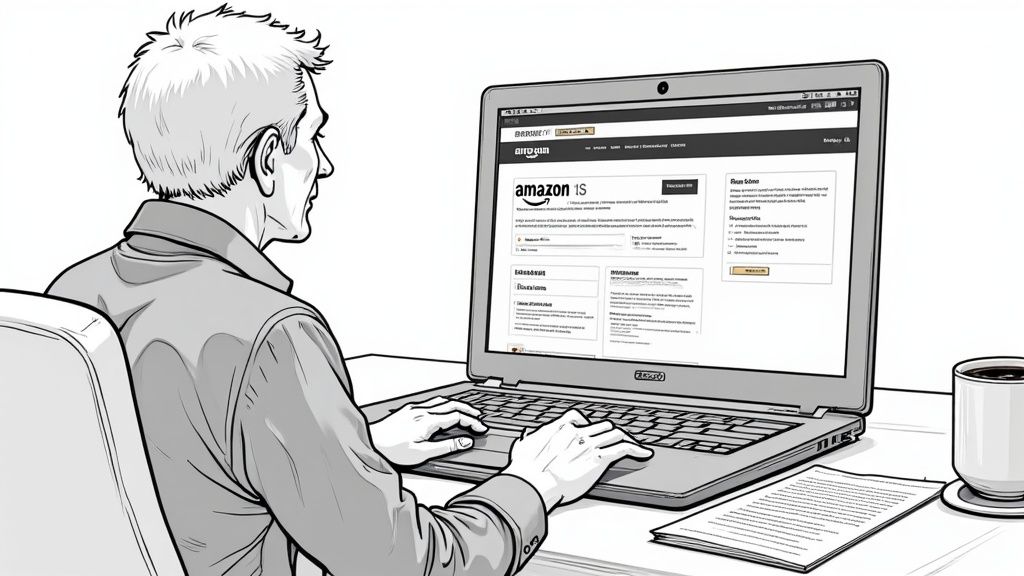Starting Your Brand Registration Journey Right

A strong brand presence on Amazon starts with proper registration. Getting your brand officially registered unlocks valuable tools and protections that give you better control over your products and listings. Let’s explore what you need to know about Amazon’s requirements, costs involved, and how to submit a successful application.
Understanding Amazon’s Brand Requirements
The foundation of Amazon’s brand registry is trademark ownership. You’ll need an active registered trademark in each country where you plan to sell products under your brand name. This can be either a standard word mark (just text) or a design mark that includes both text and graphics. For instance, if your brand is called “ExampleBrand”, you could register just the name or a logo incorporating it. While the process might seem complex at first, breaking it down into clear steps makes it much more manageable.
Trademark Costs and Misconceptions
Getting your trademark registered involves several costs to consider. The basic filing fees with trademark offices like the USPTO typically range from $225 to $400 per product category. Many sellers also work with trademark attorneys, which adds around $500-700 to the total cost. This means you should budget approximately $750-1000 for registering a single product category. A common mistake is thinking that simply using a brand name gives you ownership rights. The reality is that only a registered trademark provides the legal protection Amazon requires. Planning for these expenses early helps avoid delays in your brand registry process.
Preparing Your Application Materials
Success with your brand registry application comes down to having all the right documentation ready. Amazon needs specific details to verify your brand ownership, including your brand name, trademark registration number, and product categories. You’ll also need clear photos showing your brand name permanently attached to your products or packaging. Think of gathering these materials like preparing for a job interview – being thorough and organized upfront leads to a smoother review process and faster approval.
Timeline and Expectations
Most brand registry applications take about two weeks to process once all materials are submitted correctly. However, small errors or inconsistencies can cause significant delays. For example, if your brand name doesn’t exactly match what’s on your trademark registration, Amazon may reject the application. Successful sellers often emphasize double-checking every detail before submitting. Taking time to review everything carefully pays off by helping you access valuable brand registry benefits sooner, from better listing control to stronger protection against counterfeiters.
Navigating the Trademark Process with Confidence

Getting your trademark is a key step in registering your brand on Amazon. Let’s break down the essential parts of the process so you can protect your brand for the long run.
Choosing the Right Trademark Type: Word Mark vs. Design Mark
When starting the trademark process, you’ll need to decide between a word mark and a design mark. A word mark protects just the text of your brand name – for example, “ExampleBrand” would be protected regardless of font or style. Design marks, on the other hand, protect a specific visual logo that includes your brand name, like a special “E” design with “ExampleBrand” written below it. Your choice depends on your plans – if you want flexibility to change your logo while keeping the name protected, go with a word mark. If your specific logo design is central to your brand identity, a design mark makes more sense.
Conducting a Thorough Trademark Search
Before filing anything, you need to search existing trademarks carefully. The last thing you want is to invest time and money building your brand only to find out someone else already has rights to a similar mark. For instance, if you want to use “Mountain Fresh” for your soap brand, you’d need to check if anyone else is using that name for similar products. While you can do basic searches using free tools, working with a trademark attorney gives you a much more complete picture and helps avoid problems down the road.
Preparing Your Trademark Application and Documentation
After choosing your mark type and confirming it’s available, it’s time to prepare your application. The details really matter here – even small mistakes can lead to delays or rejections. Make sure your brand name matches exactly what you’ll use on Amazon. If you’re filing for a design mark, include clear, high-quality images of your logo and product packaging showing the brand. Think of this like preparing important legal documents – everything needs to be precise and complete.
Handling Office Actions and Examiner Feedback
Don’t worry if you get an “office action” from the trademark office requesting more information or clarification – this happens pretty often. The key is responding quickly and thoroughly. For example, if they ask for proof that your mark is being used in commerce, you’ll need to show clear evidence of sales and marketing materials. A trademark attorney can be really helpful here, guiding you through the legal requirements and improving your chances of success.
Getting your trademark right is crucial for Amazon brand registry. When you take care of these details early on, you avoid headaches later and set yourself up for success on Amazon. Just like you wouldn’t build a house without a solid foundation, taking time to properly secure your trademark gives you the protection you need to grow your brand with confidence.
Making Your Amazon Brand Registry Application Shine

Once you’ve secured your trademark and gathered all your documents, creating a strong Amazon Brand Registry application is essential. A well-prepared application can help you avoid weeks of back-and-forth with Amazon’s review team and get your brand approved faster. Let’s look at how to make your application stand out.
Presenting Your Brand Assets Effectively
The way you present your brand assets makes a big difference in the approval process. Amazon needs to see a clear connection between your trademark, products, and brand identity. For example, make sure your brand name appears exactly the same way on your product packaging as it does on your trademark registration. Even small differences, like using “ExampleBrand Co.” on packaging when your trademark shows “ExampleBrand,” can lead to rejection.
Your logo presentation matters too. If your logo is part of your trademark, include high-quality, clear images that show it perfectly. Blurry or low-resolution logos can raise red flags with Amazon’s review team and slow down your application. Take time to prepare professional, sharp images that showcase your brand’s visual elements at their best.
Photographing Products to Meet Amazon’s Standards
Good product photos are key to getting approved. Amazon wants to see clear images showing your brand name or logo permanently attached to your products or packaging. Think of these photos as proof that connects your brand to your physical products. Take well-lit, focused shots that clearly show your branding without any distractions. Skip lifestyle photos or staged scenes – stick to clean product shots that highlight your brand name or logo. The goal isn’t to sell your product features but to prove you own the brand.
Organizing Your Documentation for Speedy Review
The way you organize your application materials can speed up or slow down the review process. Clear labeling and logical organization help Amazon’s team find what they need quickly. For example, if you sell multiple product lines, create separate folders for each one with clear category labels. Think of it like preparing a court case – the better organized your evidence is, the faster the judge can make a decision. Create a simple checklist to make sure you include all required documents and avoid delays from missing information.
Addressing Common Application Challenges
Planning ahead helps avoid common issues that can delay approval. Many sellers struggle when they have multiple product lines or brand variations to register. One helpful approach is making a detailed spreadsheet listing each product line, its trademark information, and Amazon category. This becomes your master reference to keep everything consistent across your application. Having this organized system not only helps with your initial application but makes it easier to update your brand registry later on. By preparing for potential roadblocks upfront, you’ll have a smoother path to getting your brand registered and protected on Amazon.
Unlocking Brand Registry’s Hidden Potential
Getting your brand registered on Amazon is just the beginning. The real opportunity lies in knowing how to use the full suite of tools and protections that come with Brand Registry. When used strategically together, these features can help you build a stronger brand presence, boost your sales, and create lasting connections with customers.
A+ Content: Creating Product Pages That Convert
A+ Content gives you the power to tell your product’s full story through rich visuals and detailed information. Rather than settling for basic bullet points, you can showcase your products with lifestyle images, comparison charts, and in-depth features. For instance, if you sell hiking boots, you could use A+ Content to display detailed construction diagrams, show the boots in action on muddy trails, and help shoppers compare different models. This deeper level of detail helps customers make confident buying decisions, leading to better conversion rates.
Brand Protection That Works
The numbers speak for themselves – in 2023, Amazon Brand Registry blocked 99% of suspected counterfeit listings. The system gives you robust tools to guard against unauthorized sellers and fake products, including automated monitoring that quickly spots and removes problem listings. You can also use the Transparency program, which puts unique codes on each product, making it nearly impossible for counterfeiters to copy your items. This strong protection keeps your customers happy and your sales authentic.
Growing Your Community Through Posts
Great product listings are essential, but building real connections with customers takes more. That’s where Posts come in – think of it as your brand’s social media hub right on Amazon. You can share behind-the-scenes content, lifestyle photos, and videos that show up in your product feeds and brand store. Brands that maintain at least 10 active posts see much higher store visits and follower counts. By sharing content that reflects your brand’s personality, you can build a community of engaged customers who keep coming back.
Short Videos That Sell on Amazon Inspire
Video is becoming the language of online shopping, and Amazon Inspire helps you speak it fluently. Similar to the short videos you’d see on popular social apps, Inspire lets you showcase your products in action through quick, engaging clips. This format is perfect for demonstrating how products work in real life and highlighting their best features. It’s a fresh way to catch shoppers’ attention and help them discover your brand.
Building Long-Term Customer Relationships
The real power of Brand Registry comes from using all these tools together to create lasting customer loyalty. When you consistently deliver quality content, engage with customers through Posts and Inspire, and protect them from fake products, you build trust. That trust turns into repeat purchases and positive reviews. By taking full advantage of these tools, you can create an experience that keeps customers coming back and helps your brand grow steadily over time.
Building Your Global Brand Presence

Taking your brand beyond your home market requires careful planning and strategy. Let’s explore how to effectively register and establish your brand presence globally on Amazon. Success in international markets comes from understanding each region’s unique characteristics and requirements.
Navigating International Trademark Requirements
Just as you need USPTO registration to sell in the US, each international market requires its own trademark protection. For European expansion, the European Union Trademark (EUTM) offers a practical solution by covering all EU member states in one registration. This saves time compared to filing separately in each country. Be sure to research specific trademark rules for each target market to ensure full protection of your brand rights.
Managing Multiple Marketplace Registrations
Once you have trademark protection, the next step is registering your brand across different Amazon marketplaces. Stay organized by creating a tracking system – a simple spreadsheet works well to monitor requirements, deadlines and documentation for each marketplace. Having this information in one place makes it easier to maintain consistency and plan future expansions.
Coordinating Your Global Brand Presence
Registration is just the beginning – maintaining brand consistency across markets is crucial. Your brand name, logo and core message should stay recognizable whether customers find you in Germany, Japan or Brazil. While product descriptions may need translation, keep your fundamental brand identity intact. This builds trust with international customers who come to recognize your brand regardless of location.
Adapting Your Brand to Different Cultures
Building global brand recognition requires more than translation – it needs cultural understanding. Colors, images and messaging that work well in one country might miss the mark in another. Take time to learn about cultural preferences in each market. Consider working with local experts who understand nuances that could impact how your brand is perceived. This attention to cultural context can significantly boost your success in new markets.
Handling Multiple Language Listings
While English is common globally, customers prefer shopping in their native language. Professional translation of your listings shows commitment to serving local markets properly. Don’t rely solely on machine translation – have native speakers review your content to ensure it reads naturally and connects with local buyers. Quality translations build credibility and improve the shopping experience. With careful attention to these various aspects of global expansion, you can successfully establish your brand across Amazon’s international marketplaces.
Measuring and Maintaining Your Brand’s Success
Building your Amazon brand is just the first step – maintaining and measuring its success requires ongoing dedication and smart strategies. Like tending to a garden, your brand needs consistent care and attention to thrive long-term.
Key Metrics for Brand Health on Amazon
Understanding your brand’s performance requires tracking specific metrics that reveal both immediate issues and long-term trends:
- Unauthorized Listing Removal Rate: Shows how well you’re handling unauthorized sellers. High removal rates mean your protection measures are working.
- Conversion Rate: The percentage of page views that turn into sales. When your A+ Content connects with shoppers, this number rises.
- Customer Reviews and Ratings: These build trust and drive sales. Watch them closely and handle negative feedback quickly.
- Brand Store Traffic: Track visits and engagement to see if your store effectively attracts and keeps shoppers’ attention.
- Share of Voice: How often customers see your brand versus competitors. Boost this through targeted ads and compelling content.
Regular review of these numbers helps spot issues early and shows where to focus improvement efforts.
Maintaining Brand Protection: Proactive Strategies
Protecting your brand on Amazon works best with prevention rather than reaction. Think of it like maintaining a security system – you need regular checks and quick responses when issues arise:
- Systematic Monitoring: Check listings regularly for unauthorized sellers using Brand Registry tools to catch problems early.
- Swift Violation Responses: Report unauthorized activity immediately to minimize damage to your brand’s reputation and sales.
- Smart Tool Usage: Make full use of Amazon’s protection features like Transparency and Project Zero. For example, Transparency’s unique product codes make spotting fakes much easier.
Just as weeding keeps a garden healthy, consistent monitoring keeps your brand strong.
Measuring ROI on Brand Registry
To see if Brand Registry is worth your investment, compare key metrics before and after enrollment. Look at changes in conversion rates and how quickly unauthorized listings get removed. These concrete numbers show the program’s real impact on your business.
Continuous Brand Optimization
Keeping your brand strong on Amazon takes ongoing work. Update your brand content regularly, including A+ Content and Brand Store pages. Fine-tune protection strategies based on what your metrics show. For instance, if unauthorized sellers spike in certain categories, adjust your monitoring approach accordingly. This constant refinement helps your brand stay competitive and resilient.
Ready to take your Amazon brand to new heights? eStore Factory, a three-time Amazon SPN Award Winner, brings expert guidance and proven services to optimize your storefront, increase sales, and protect your brand. With over 10 years of experience helping 5000+ brands generate $250+ million in sales, we know what works. Visit us today to start growing your Amazon business.

